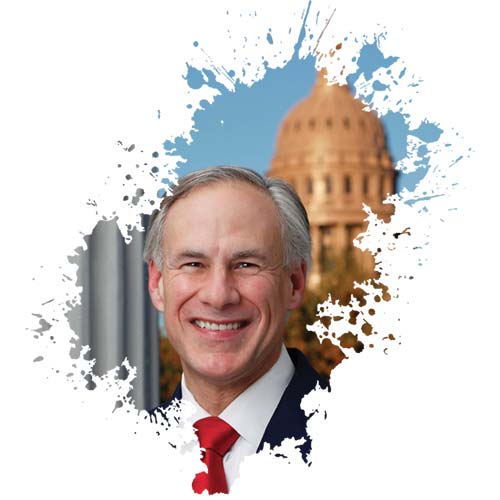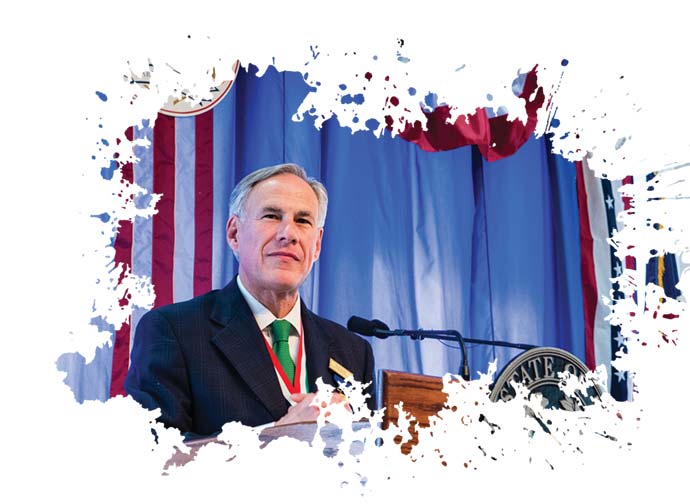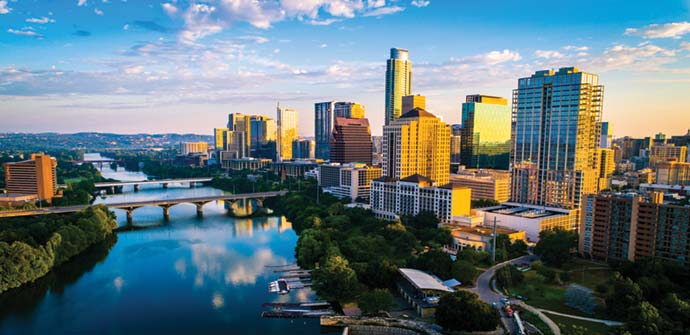We’re running out of superlatives by which to appraise the Texas economy and business climate. Site Selection readers likely are aware that the Lone Star State has claimed our coveted Governor’s Cup seven years in a row, signifying a record run for corporate expansion projects.
With expansion come jobs, and with jobs come people. According to U.S. Census numbers delivered in May, Texas accounts for five of the country’s 10-fastest growing cities with 50,000 residents or more. (New Braunfels, Frisco, McKinney, Georgetown, and Rowlett). Four Texas counties made their Top 10 (Comal, Kaufman, Midland and Hood).

Home to such Fortune 500 powerhouses as AT&T, American Airlines, Sysco and NEC, Texas is hardly the one-trick petroleum pony that some still may imagine. The state has become a leader in advanced manufacturing, aerospace and defense, life sciences and information technology. Were Texas a country, its GDP of $1.8 trillion would rank it 10th in the world.
Gov. Greg Abbott, elected to a second four-year term in office in 2018, is an unabashed champion of his state’s approach to business.
“The Texas model,” Abbott tells Site Selection, “is very simple. It can be replicated very easily and it’s scalable to any size of government. First is, you keep taxes low. Second is that you streamline and keep regulations simple and predictable. Third is, you constantly work on advancing your workforce to meet the needs of employers.”
In a wide-ranging August interview, Abbott explained how Texas is working to make its business climate even better, while taking aggressive steps to manage its robust growth. Not surprisingly, Abbott is bullish on the future. The interview has been edited for clarity and length.
Site Selection: As we begin to lean into the end of this calendar year, how do you feel about the state of the Texas economy?
Gov. Greg Abbott: The economy is looking very, very strong. There seems to be no letup in the strength of either the economy or in job growth, or the number of companies that continue to come here and grow here. So, things are looking very, very good.
What makes you optimistic about 2020?
Gov. Abbott: There’s a tailwind for businesses to continue to relocate to the state of Texas. The cost of doing business in other states continues to be much higher than the cost of doing business in the state of Texas. And as a result, Texas is a magnet for businesses looking to flee either taxation or regulation or other drivers of costs in other states. We’ll continue to see a very large influx of businesses from California, from Illinois, from New York and so many other places. At the same time, we just had a legislative session that ended at the end of this past May. And in the aftermath of that session, we made Texas an even more attractive location for business, whether it’s for those already here looking to grow or for those from another state looking for a place to go to.
A couple of quick examples: One, as you know, Texas has no personal or business income tax. And one of our main sources of revenue is a property tax. We passed substantial property tax reform this session that achieved two things. It reduced property taxes in the coming year by about 7% and more in the year after that. Those decreases will continue in years going forward.
Secondly, we did more this last session than any session ever to limit the growth of government and limit the ability of government to be able to increase your property taxes in the future. For schools, we put in a 2.5% property tax revenue cap to make sure that they cannot jack up your property taxes. And for cities and counties we put in a 3.5% property tax revenue cap. So, as attractive as Texas was economically for this session, it’s even more attractive in the future.
Do people seem surprised when you tell them that Texas leads the nation in technology exports?
Gov. Abbott: Yes, they are surprised. Texas has led the nation in exports for more than 15 years, but we have led the nation in technology exports for something like seven years. And people are shocked to know that because they often think of California as leading in technology. But when you see what’s going on in Austin, for example, or what’s happened over the past five to 10 years, as we are talking right now, they are in the early stages of building a 36-story building in downtown Austin that will be home to Google. In addition to that one building in the heart of downtown, there’s another site just across Interstate 35 in downtown where Google is adding another seven-story building. So, Google’s footprint here will be massive. At the same time, Facebook is expanding rapidly in Texas. Also, we had a groundbreaking this past December, where Apple is adding a huge, massive campus in North Austin that will house up to 15,000 new employees.
When you speak with Texas exporters, what are they expressing to you about the international trade climate?
Gov. Abbott: Well, I speak to them frequently. And the conversation has increased in frequency as the tariffs began to escalate. Most of the focus in my conversations with exporters dealt with trade tensions with Mexico. And those have largely been resolved. And, you know, there was a tariff situation for a short period of time, and so I spent some time working with the administration in Washington to make sure that those issues were going to be resolved as quickly as possible. And they were. I would say that the trade situation with Mexico is good. Now, I do want to see the United States Congress step up and do its job and finalize approval of the USMCA, which is extremely important to Texas. As we talked about earlier, Texas is the number one export state in the United States of America, and Mexico and Canada are our two largest district partners. So, the passage of the USMCA is very important.
In addition to that, some steel-based tariffs and some other issues along those lines were pressing issues for primarily the oil and gas industry. We are in the process of building a lot of oil and gas pipelines from the Permian Basin to the Gulf Coast for exporting or processing of oil and gas. And there are specialty pipes that were being used to transport that oil and gas that required a type of steel that is not manufactured in the United States. And so it slowed down the ability of the oil and gas sector to be able to move on gas the way that they needed to and it created a little bit of a bottleneck. I worked with the administration in Washington on some of those issues. Part of the relief that was needed has been resolved. The sooner that we are able to resolve any type of trade tensions, it will be a huge benefit for the exporters in Texas.
That said, we understand the importance of the United States being able to address the China trade situation in the robust way that’s needed to resolve a whole lot of the broad-based conflicts. While we’re working our way through that, Texas will continue to lead the nation in exports.
As you yourself have said, 1,000 new people come to Texas to live each day. When you speak with local leaders, do they express any concern about trying to keep apace of all that growth, both economic and demographic? What are their biggest challenges?
Gov. Abbott: There is a challenge in Texas that’s common among all states right now. And that’s the low unemployment rate. Employers are looking for more employees. It’s a good thing in that it’s a challenge that goes along with a good economy. The only way to have an abundance of employees is to have a recession, where a lot of employees are being laid off. So, it’s just a byproduct of having a good economy. But I will tell you this. Texas is more easily able to deal with the employment rate for two reasons. We have a fast-growing natural population growth. Texas added more over the past year and over the past decade than any other state. About half of those new residents are newborn Texans. So, as opposed to some states, we have a fairly young population. That means that we are going to have a lot of new workers available for employers. Second, though, is Texas has proved to be a very attractive state for employees to move to. They’re coming here to work for the employers that are growing so rapidly.
“There’s a tailwind for businesses to continue to relocate to the state of Texas.”
That said, when we are adding so many people, we naturally are adding a lot of people to our roadways. But we have dedicated funding in the state of Texas where we add $8 billion dollars a year to build transportation facilities, primarily roads, to make sure that people are getting around a whole lot faster. As a result, we are able to do more to accommodate the road needs, the transportation needs, of all the people living here.
On that topic, according to a Texas A&M study, congestion is robbing the state economy of well in excess of $11 billion a year. Do you have any special concerns about that I-35 corridor, which is so crucial to your state’s economic engine?
Gov. Abbott: If you look at the way Texas is growing, you see that the growth seems to be in fair proximity to I-35, which is one of the largest and most important road corridors in the country. To give you an example, this past calendar year Laredo was identified as the largest port in the United States of America, exceeding Los Angeles, which had been previously number one. So, there are more goods passing through Laredo, which is an inland port, than any other port in the United States. And Laredo is on the southern tip of the I-35 corridor, which comes up through San Antonio and Austin and Dallas. So, there’s a lot traveling through that corridor. As a result, we have been building out the I-35 corridor in so many places ranging from north of Dallas to south of San Antonio. There is a middle segment of it where we will be announcing a buildout fairly soon. And that is in the Austin-Central Texas area, where we will work to unclog that part of it.
The Chapter 313 incentives that cap business property assessments for certain large manufacturing projects are set to expire in 2022. Do you expect to have to fight with the legislature to preserve them?
Gov. Abbott: We’ll see. It was an issue that some legislators brought up this past session. And I know that there will be a robust debate about it in the next session.
Are you willing to expend political capital to keep those incentives in place?
Gov. Abbott: We’ve got to look at it topside and bottom and make sure that the incentives are working the way they need to be working.
Are there revisions to 313 that you would favor?
Gov. Abbott: We want to make sure that incentives are aligned and make sure that we are bringing in companies and businesses that are choosing Texas as opposed to some other place. We need to ensure that they are serving as an incentive as opposed to a handout.
This goes back to something we were speaking about a moment ago. Texas, far and away, is America’s leader in wind power capacity. You’re moving very quickly and decisively on solar. But given the importance of the oil and gas industry to your state’s economy, is there a need to plan for the continuing growth of renewables?
Gov. Abbott: We are doing that. We are working rapidly on renewables. Yes, we have a prominent position in wind, and we are moving very rapidly in solar. We’re just fortunate because of our size and geographic location. If you look at the vast area of West Texas, it looks like it was naturally made for massive solar farms. And I would not be surprised if Texas, maybe one day soon, was the national leader in solar. All we really need to do to be able to achieve that, candidly, is be able to improve the ability to capture solar energy in a cost-efficient way, as well as being able to store it and move it. Once those things can be achieved in an economical fashion, I think Texas will be number one for solar. But we will continue to make advancements in both of those areas.

Have you been surprised at all at the persistence of public opposition to some of the LNG facilities proposed for the Rio Grande Valley?
Gov. Abbott: I know it’s been a long-going issue in the area. And I think that, without knowing all the details, something I’ve picked up is that they want to build out the port there, but they would prefer it to be more of a cruise line port as opposed to an energy-based port. But I think that both can be achieved. And when you look at the coming acceleration that we hope to see in SpaceX, then you’re really looking at an LNG port and a space port down there, and it could be a very robust economy for the Rio Grande Valley.
What can the rest of the country learn from the Lone Star State, economically, politically and culturally?
Gov. Abbott: The Texas model is very simple. It can be replicated very easily and it’s scalable to any size of government. First is, you keep taxes low. Second is that you streamline and keep regulations simple and predictable. Third is, you constantly work on advancing your workforce to meet the needs of employers. You have litigation reforms. And you have right-to-work laws that prevent union abuses that you see in some other states. And it’s frankly just that simple. We’ve been fortunate that our competitors, the other states, for whatever reason have not adopted that very simple Texas model. If they did, we would face different competition going forward.”

